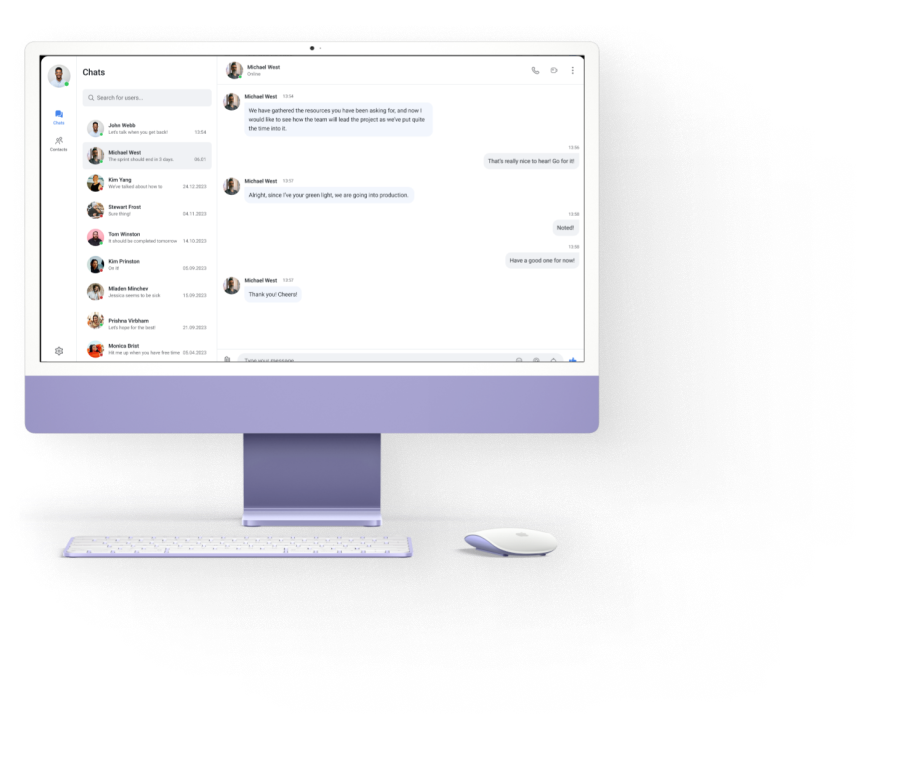Learning how to be more productive doesn’t just mean finding ways to fit more tasks into your schedule. The most productive people aren’t necessarily those who never step away from their computer, or commit to 12-hour work days. Often, they’re actually the people who learn how to work “smarter” instead of “harder”, using their energy and time to their advantage.
Whether you want to learn how to be more productive working from home, or you want to ensure your work ethic is shining at the office, it’s important to remember achieving success takes time. Productivity isn’t something you master overnight. It stems from a collection of habits you cultivate carefully, based on what you know about your own workflow and ability to focus.
Today we’re going to explore some of the most effective ways you can deploy to become a healthier and more productive human being, both in the workplace and outside of it.
How to Be a More Productive Person: Defining Productivity
Before we begin looking at the tools and strategies you can use to harness productivity, it’s worth getting a clear idea of what “productivity” actually is. Although this term appears frequently in the business world, it’s often misunderstood.
Many assume that productivity correlates with time management and how we organize our days. However, there’s more to productivity than developing the right schedule. True productivity involves learning how to use your brain and your body as efficiently as possible. Productive people know how to achieve their goals consistently, by leveraging the right tools and strategies.
While the habits of highly productive people vary, they often center around overcoming the common challenges that can sap our energy and concentration each day. When you learn how to be a more productive person you discover how to avoid procrastination, delegate tasks effectively and focus your attention on the tasks that matter most.
Not only does productivity make employees more valuable in the workforce, but cultivating productivity can also benefit you in other aspects of your life too. When you’re more productive, you’re less likely to be overwhelmed by your to-do list. You might experience less stress, fewer anxieties, and better overall physical and mental health.
How to Be More Productive in 11 Easy Steps
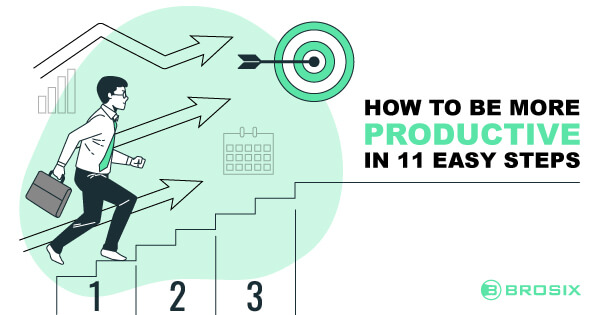
Learning how to be more productive at work also teaches us how to manage our time and focus effectively in everyday life too. When you get into the habit of organizing your to-do list, cultivating focus and avoiding distraction, it influences everything you do.
While developing a good level of productivity does take time and effort, it’s something anyone can accomplish with a little hard work.
Here are some steps you can take to boost your productivity every day.
Step 1: Create Plans for Every Project
Failing to plan means planning to fail. Establishing exactly how you’re going to reach your goals, with a step-by-step strategy, means you’re more likely to approach each task with the right mindset. Researchers have even found that planning activities and writing to-do lists helps to reduce the strain on your brain by preventing you from worrying too much about unfinished tasks.
When developing your plan, think about what you need to do, when you need to get each task done, and how much time and effort you’ll need to dedicate to each stage of the process.
If you end up with a list of tasks to complete, it’s up to you to decide how you’re going to organize your day. Some people find it easier to start with simple tasks, particularly if they have trouble focusing. If you’re not an early bird, learning how to be more productive in the morning can be tough. Managing simple tasks first can help set you up for success with quick wins.
Alternatively, you might prefer to focus on the hardest tasks first, to get them out of the way. This strategy also means you can focus all of your attention on the most important projects you need to address before you lose your motivation and energy.
Step 2: Use a Time Management Matrix
While good time management and productivity aren’t always the same thing, they often go hand in hand. Regardless of whether you’re working on a solo project, or collaborating with a team, it’s important to identify exactly what the biggest priorities on your list are.
A good way to make sure you’re managing your time effectively, is to use a time management matrix, such as the Eisenhower Matrix. Basically, all you need to do is create a two-by-two square, with “important” and “not important” on one axis, and “urgent” and “not urgent” on the other.
Examine each of the tasks on your to-do list, and place them into the matrix based on their level of importance (the value they offer) and how quickly you need to get them done. This strategy will also help you eliminate items from your schedule that are simply wasting your time.
Step 3: Break Big Tasks into Small Pieces
Have you ever wondered why you tend to procrastinate, rather than jumping straight into the things you need to do? There could be a number of reasons, but one of the most common excuses people give for procrastination is that their tasks seem too daunting to tackle.
If your to-do list is too overwhelming, then even thinking about getting tasks done places a tax on your body and brain. If you want to be more focused and productive, starting by breaking big tasks into smaller chunks can be a good idea.
For instance, if your task was to “write an article about productivity”, you could break this down into little chunks, starting with researching the topic, looking for keywords, creating a mind map, then writing the introduction, followed by one section at a time.
Step 4: Take More Breaks
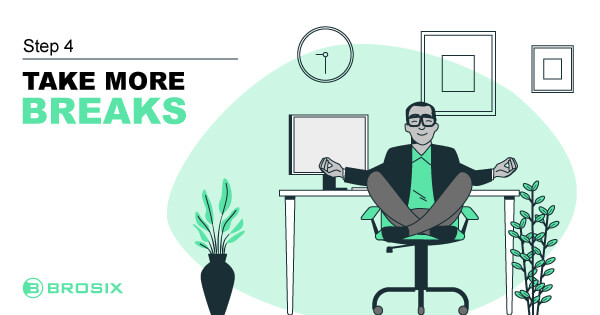
Many business leaders and employees alike make the mistake of assuming that productivity requires you to work non-stop, without any breaks. We assume that by constantly jumping from one task to the next in our day, we’ll get more done. However no-one has unlimited focus.
Ultimately, the longer you force your brain to concentrate, the more exhausted you’re going to become. That’s why taking breaks is a great way to refresh your synapses and get your brain back on track. Research shows that taking even brief breaks can make you more productive, creative and efficient in the workplace.
The key to using breaks effectively is making sure that you’re leveraging them properly in your schedule. Don’t just take a break when you’re in the middle of doing something because you feel like it’s the “right time”. Schedule your breaks for when they make the most sense. For instance, you might work intensely for 30 minutes, then take a five-minute break.
Step 5: Take Care Of Yourself
If you want to learn to be a healthier and more productive human being, then you need to remember that your body and brain are only capable of so much. If you’re not looking after your wellbeing, then you’re going to hit a wall with your productivity sooner or later.
Taking little steps to look after yourself, like eating a healthy diet and exercising frequently, can have a direct impact on how well you’re able to focus. In fact, research shows that adequate nutrition can improve productivity levels by around 20% on average. Avoid relying on caffeine and sugar to keep your energy levels high and instead concentrate on staying nourished and hydrated.
Alongside eating well, make sure you set time aside in your day to move around, stretch your muscles and keep your blood pumping. Another way to look after yourself is by getting plenty of sleep. The world’s most successful people consistently report that getting a good night’s sleep is crucial to reaching goals, both at work and in their personal lives.
Step 6: Minimize Distractions
While some productive people seem like they can ignore distractions without batting an eyelid, there’s no need to bombard yourself with reasons to procrastinate. Examine your current workflow, and ask yourself where you’re most likely to be distracted from focused periods of work.
If you’re constantly receiving emails, it might be worth putting your notifications on mute, or closing your inbox for a while when you’re trying to concentrate. If you’re tempted to browse social media, prevent yourself from visiting those platforms by blocking them on your browser for a short while.
If you simply find yourself thinking distracting thoughts when you’re supposed to be focusing on something, it might help to create a “distraction list”. This is basically a piece of paper or a document where you can make a list of all of the thoughts that come to mind when you’re working. You can always check the list later to make sure you’re not forgetting anything important.
Step 7: Improve Your Communication Strategy
Communication and collaboration are often key to staying productive. There’s a good chance that many of the tasks you need to complete each day will revolve around your ability to connect with other people. However, the communication strategies we use in today’s modern world can be distracting.
Emails cause headaches by forcing you to wait around for responses when you need a quick answer to a question or search through dozens of disconnected threads. Endless calls and meetings force you to take your attention away from whatever you’re doing, so you’re less likely to reach your goals.
The best strategy is to find a communication tool that allows you to collaborate in the method that makes the most sense for each project you’re tackling. A solution like Brosix offers an excellent alternative to traditional communication strategies by allowing you to leverage video calls, scheduled meetings, messages and more, all in the same place.
You can even combine your collaboration tool with your productivity apps in the same place, tracking your to-do list while you’re communicating with colleagues.
Step 8: Use Technology to Save Time
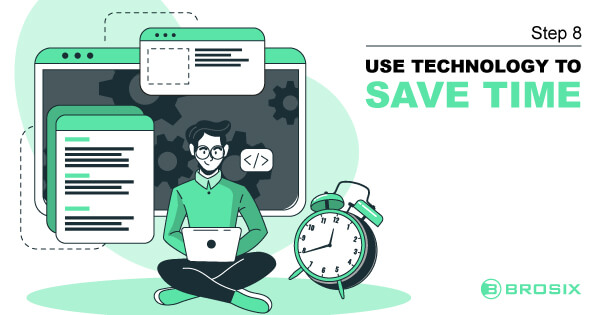
Just as collaboration and communication platforms can help to boost your productivity by giving you access to the right tools for team work, other tech solutions can come in handy too. For instance, if you’re constantly spending hours writing response emails to customers, you could consider using an AI-enhanced tool which suggests quick responses on your behalf.
By using productivity apps and software solutions, you can automatically send projects to other members of staff and ask for tasks to be approved with reminders and notifications, without having to pursue your colleagues yourself. You could even use your tools to create standard operating procedures for common tasks, which you and your team members can follow.
If you’re comfortable leveraging the power of technology, there are plenty of tools out there that can help you automate simple tasks that would otherwise consume a lot of your time. For instance, AI solutions can automatically convert meetings into notes and summaries.
Step 9: Stop Multitasking
Just as many business leaders make the mistake of thinking they need to focus non-stop to be productive, they also commonly assume that multi-tasking helps them complete more tasks, faster. However, if you want to learn how to be more productive at work and in life, one of the best things you can do is concentrate on completing one task at a time.
Research on multitasking shows that it hampers, rather than improves productivity. When you multitask, you aren’t just doing two jobs at once, you’re trying to divide your focus between two separate things. Every time you switch your attention to a new place, you need to regain your focus, which means you lose valuable time.
To make matters worse, multitasking often means that you stop giving your full attention to a specific project, which leads you to be more prone to making mistakes. There are instances where multi-tasking might come in handy, such as when you’re listening to a podcast and writing emails. However, for the most part, it’s best to list the tasks you want to do and tackle them one by one.
Step 10: Manage Your Energy, as Well as Your Time
As mentioned above, good time management is often a crucial part of being more productive. However, it’s not just your time you need to think about. While we all only have so many hours in the day when we can focus on work and our goals, we also have varying amounts of energy we can contribute to a project.
If you use up all of your energy before you even get around to starting a crucial task, it doesn’t matter how many hours you have left to finish the project, you’re still not going to get a lot done. This is one of the reasons why many successful people recommend tackling the most important tasks on your to-do list first, when you’re still brimming with energy.
However, it’s worth remembering that everyone’s energy levels are different. The good thing about the rise of remote and flexible work, is that many employees now have more freedom to effectively plan their schedules around the times when they have the most energy. If you think you’re naturally more productive later in the day, then concentrating on your most important tasks after lunch might be the right strategy for you.
Step 11: Know When to Say No (and Delegate)
Finally, part of being a more productive person and using your time as efficiently as possible, is knowing exactly what you should be devoting your time and focus to. In other words, stop wasting time and effort on tasks that aren’t relevant to your skills and goals.
This starts with knowing when you should say “no” to requests, whether they’re made by your boss, your colleagues or members of your family. As difficult as it might be, knowing when to say no means you can reserve more of your energy and time for the things that really matter.
At the same time, it’s helpful to know how to effectively delegate tasks to the right people in your team, or throughout your workforce. Delegation isn’t just about offloading the work you don’t want to do onto other people. It’s about considering which projects you’re most equipped to tackle, based on your skills and your schedule.
Don’t just force yourself to handle everything because you’re afraid of passing the reins to someone else. Learn how to delegate when a task isn’t right for you.
Learning How to Be More Productive in Life
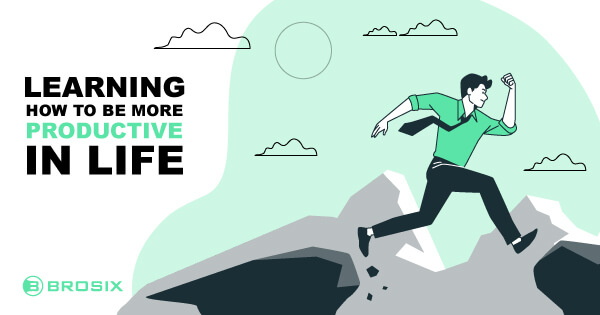
Ultimately, learning how to be a healthier and more productive human being is a process that takes time and effort. We’re all capable of high levels of productivity when we have the right environment and tools to help us. However, it’s up to you to ensure that you’re actually making the most of your energy and time.
The steps above should provide you with a useful insight into just some of the ways you can boost your productivity over time. However, remember that as you learn more about your working style, the tasks you face each day and the challenges you need to overcome, it’s important to adapt. The strategies you use for productivity today may not be the same as the ones you’ll use in the future.
One thing that will always contribute to improved productivity is collaboration and communication. Leveraging tools like Brosix can help you to stay connected, so you can benefit from the strengths of your team members and produce amazing work.






